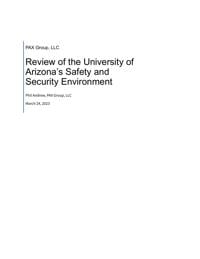The University of Arizona had an alarming lack of safety measures and ineffective investigations into threats up to a year before Professor Thomas Meixner was shot and killed on campus, a report released Monday revealed.
The UA hired consulting firm PAX, LLC to review its campus safety protocols after the October shooting. The company’s 205-page report lists 33 recommendations for the UA to adopt to improve its safety protocols while reviewing the systems it says contributed to a breakdown of security.
The PAX report is a direct response to the shooting of Meixner, the department head of the UA’s Hydrology and Atmospheric Sciences Department. Murad Dervish, a former graduate student, is facing charges in connection with the shooting that occurred inside the hydrology building. Throughout the year before the shooting, Meixner and his colleagues received threatening communication from Dervish, who had been expelled and barred from campus by early 2022.
“As this report reveals, there were systemic issues across our university that should have been identified and corrected. I’m angry at myself that I did not do more to prevent this tragedy,” UA President Robert Robbins said at a news conference Monday, a few hours after the report’s release. “I’m determined to honor Tom Meixner’s legacy by making any and all necessary changes to keep our campus safer,” Robbins added later.
The report’s alarming conclusions about a lack of appropriate crisis response measures from the UA come after Meixner’s family filed a notice with the Arizona Board of Regents on Friday. It seeks $9 million over the university’s response to the death, alleging the shooting was a “direct consequence” of the UA’s failure to respond to repeated threats by Dervish. The Arizona Board of Regents has 60 days to respond to the claim, a precursor to a lawsuit.
“If the University of Arizona fails to accept responsibility and compensate the Meixners for their enormous losses, we are prepared to file a lawsuit to seek the full measure of justice for our clients,” said Larry Wulkan, a lawyer with the law firm representing Meixner’s family.
When asked about the claim Monday, Robbins explained the process must go through the board of regents, but said “I think it’s a very positive development in this case.”
Lack of safety planning
The report breaks down three main themes in need of improvement: understanding and managing threat; providing a consistent, empathetic and compassionate response; and the decentralization and breakdown of communications.
Concerns expressed by members of the hydrology department about Dervish’s mental health “should have led to a series of law enforcement investigative steps,” especially given his criminal background, the report says. In January, the UA implemented a policy requiring all graduate assistants to go through a background check before they can start work for the university.
Some of the most salient findings in the report outline inconsistent security protocols, including that the UA “does not consistently or centrally coordinate training, awareness, or reporting of safety and security concerns” and lacks a readily available reporting system for safety threats.
When the shooting happened on Oct. 5, many community members misunderstood the emergency alert issued and ignored it, according to the report. Many of those interviewed by PAX could not recall the last time an emergency response drill happened at the school.
Furthermore, departments reporting safety concerns are left to “manage things internally until the situation reaches a level of potential violation” of the UA’s code of conduct, according to the report. Each department is encouraged to have an emergency response plan but isn’t mandated to adopt one, according to the report.
“A shift in mindset must develop across the entire university community so that safety and security are taken as seriously as laboratory safety or risk management regulations by connecting safety and security with the dedication to commercial, occupational, and resource protocols already established,” the report says.
Issues with key threat-assessment group
The report says the UA Police Department failed to aggressively pursue Dervish or operate with other law enforcement jurisdictions to investigate his threats. Officers attempted to arrest him at his residence on April 15, 2022, but failed to do so after Dervish refused to come out.
“Overall, the university’s culture of moving from incident to incident, without improving the process to create a clear threat management and investigative strategy, led to missed opportunities for mitigation and intervention,” the report states.
The report also breaks down the actions of the UA’s Threat Assessment Management Team, or TAMT, which determines when individuals pose significant threats on campus. The report says the group inadequately responded to the reported threats from Dervish, leading to “a series of decisions and actions that presented multiple opportunities for the Subject to continue to harass and threaten University of Arizona community members.”
A lack of an appropriate threat assessment tool led to reports on Dervish to be siloed throughout different reporting agencies without a coordinated mechanism of tracking them together. The disbanded approach led to “each TAMT member hesitating to offer a proactive response” as it failed to show a complete picture of the threat Dervish posed. The TAMT does not have a designated team lead or a consistent process to address cases, according to the report.
It’s not the first time concerns about TAMT have been circulated, the report states. A different security expert group reviewed the team in April 2019 and made several recommendations for improvement, and an internal review in April 2018 led to conversations with UA leadership to improve operations. It’s not clear which, if any, of the suggestions were adopted.
The report outlines 33 recommendations for the university to adopt based on its findings, some of which the UA is already implementing. They include adopting a strategic post-crisis plan with clear guidelines on responding to future emergencies, adopting a formalized charter for TAMT with clear protocols in place, and creating crisis response plans for every department.
“I can tell you that we’ll be doing a lot of soul searching and looking at all the data and the actions that were taken,” Robbins said at the news conference. “I think there’s no one individual, it’s a collection of a lot of missed opportunities and mistakes, that we didn’t have our eye on the overall picture.”
University of Arizona President Robert C. Robbins gave a campus safety update on March 27, following the release of a report prepared by the independent PAX Group. Video by Pascal Albright, Arizona Daily Star








